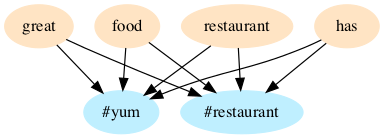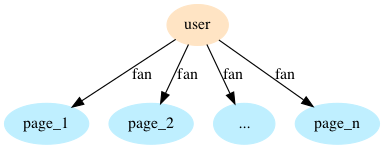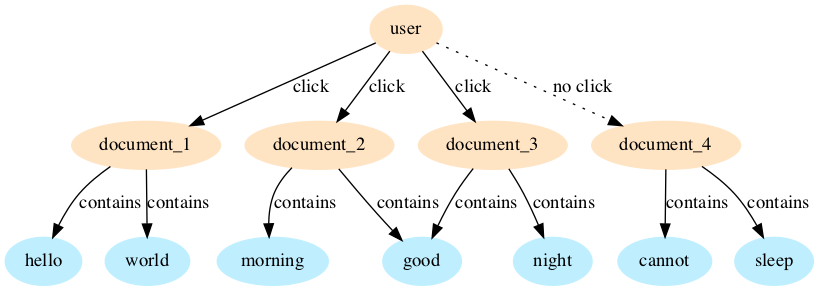StarSpace is a general-purpose neural model for efficient learning of entity embeddings for solving a wide variety of problems:
- Learning word, sentence or document level embeddings.
- Text classification, or any other labeling task.
- Information retrieval: ranking of sets of entities/documents or objects, e.g. ranking web documents.
- Metric/similarity learning, e.g. learning sentence or document similarity.
- Content-based or Collaborative filtering-based Recommendation, e.g. recommending music or videos.
- Embedding graphs, e.g. multi-relational graphs such as Freebase.
In the general case, it learns to represent objects of different types into a common vectorial embedding space, hence the star ('*', wildcard) and space in the name, and in that space compares them against each other. It learns to rank a set of entities/documents or objects given a query entity/document or object, which is not necessarily the same type as the items in the set.
See the paper for more details on how it works.
Requirements
StarSpace builds on modern Mac OS and Linux distributions. Since it uses C++11 features, it requires a compiler with good C++11 support. These include :
- (gcc-4.6.3 or newer) or (clang-3.3 or newer)
Compilation is carried out using a Makefile, so you will need to have a working make.
You need to install Boost library and specify the path of boost library in makefile in order to run StarSpace. Basically:
$wget https://dl.bintray.com/boostorg/release/1.63.0/source/boost_1_63_0.zip
$unzip boost_1_63_0.zip
$sudo mv boost_1_63_0 /usr/bin
Optional: if one wishes to run the unit tests in src directory, google test is required and its path needs to be specified in 'TEST_INCLUDES' in the makefile.
Building StarSpace
In order to build StarSpace, use the following:
git clone https://github.com/facebookresearch/Starspace.git
cd Starspace
make
File Format
StarSpace takes input files of the following format. Each line will be one input example, in the simplest case the input has k words, and each labels 1..r is a single word:
word_1 word_2 ... word_k __label__1 ... __label__r
This file format is the same as in fastText. It assumes by default that labels are words that are prefixed by the string __label__, and the prefix string can be set by "-label" argument.
In order to learn the embeddings, do:
$./starspace train -trainFile data.txt -model modelSaveFile
where data.txt is a training file containing utf-8 encoded text. At the end of optimization the program will save two files: model and modelSaveFile.tsv. modelSaveFile.tsv is a standard tsv format file containing the entity embedding vectors, one per line. modelSaveFile is a binary file containing the parameters of the model along with the dictionary and all hyper parameters. The binary file can be used later to compute entity embedding vectors or to run evaluation tasks.
In the more general case, each label also consists of words:
word_1 word_2 ... word_k <tab> label_1_word_1 label_1_word_2 ... <tab> label_r_word_1 ..
Embedding vectors will be learned for each word and label to group similar inputs and labels together.
In order to learn the embeddings in the more general case where each label consists of words, one needs to specify the -fileFormat flag to be 'labelDoc', as follows:
$./starspace train -trainFile data.txt -model modelSaveFile -fileFormat labelDoc
Training Mode
StarSpace supports the following training modes (the default is the first one):
- trainMode = 0:
- Each example contains both input and labels.
- Use case: classification tasks, see tagspace example below.
- trainMode = 1:
- Each example contains a collection of labels. At training time, one label from the collection is randomly picked as the label, and the rest of the labels in the collection become the input.
- Use case: content-based or collaborative filtering-based recommendation, see pagespace example below.
- trainMode = 2:
- Each example contains a collection of labels. At training time, one label from the collection is randomly picked as the input, and the rest of the labels in the collection become the label.
- Use case: learning a mapping from an object to a set of objects, e.g. sentence to document.
- trainMode = 3:
- Each example contains a collection of labels. At training time, two labels from the collection are randomly picked as the input and label.
- Use case: learn pairwise similarity from collections of similar objects, e.g. sentence similiarity.
- trainMode = 4:
- Each example contains two labels. At training time, the first label from the collection will be picked as input and the second label will be picked as the label.
- Use case: learning from multi-relational graphs.
- trainMode = 5:
- Each example contains only input. At training time, it generates multiple training examples: each feature from input is picked as label, and other features surronding it (up to distance ws) are picked as input features.
- Use case: learn word embeddings in unsupervised way.
Example use cases
TagSpace word / tag embeddings
Setting: Learning the mapping from a short text to relevant hashtags, , e.g. as in this paper. This is a classical classification setting.
Model: the mapping learnt goes from bags of words to bags of tags, by learning an embedding of both. For instance, the input “restaurant has great food <\tab> #restaurant <\tab> #yum” will be translated into the following graph. (Nodes in the graph are entities for which embeddings will be learned, and edges in the graph are relationships between the entities).
Input file format:
restaurant has great food #yum #restaurant
Command:
$./starspace train -trainFile input.txt -model tagspace -label '#'
Example scripts:
We apply the model to the problem of text classification on AG's News Topic Classification Dataset. Here our tags are news article categories, and we use the hits@1 metric to measure classification accuracy. This example script downloads the data and run StarSpace model on it under the examples directory:
$bash examples/classification_ag_news.sh
PageSpace user / page embeddings
Setting: On Facebook, users can fan (follow) public pages they're interested in. When a user fans a page, the user can receive all things the page posts on Facebook. We want to learn page embeddings based on users' fanning data, and use it to recommend users new pages they might be interested to fan (follow). This setting can be generalized to other recommendation problems: for instance, embedding and recommending movies to users based on movies watched in the past; embed and recommend restaurants to users based on the restaurants checked-in by users in the past, etc.
Model: Users are represented as the bag of pages that they follow (fan). That is, we do not learn a direct embedding of users, instead, each user will have an embedding which is the average embedding of pages fanned by the user. Pages are embedded directly (with a unique feature in the dictionary). This setup can work better in the case where the number of users is larger than the number of pages, and the number of pages fanned by each user is small on average (i.e. the edges between user and page is relatively sparse). It also generalizes to new users without retraining. However, the more traditional recommendation setting can also be used.
Each user is represented by the bag-of-pages fanned by the user, and each training example is a single user.
Input file format:
page_1 page_2 ... page_M
At training time, at each step for each example (user), one random page is selected as a label and the rest of bag of pages are selected as input. This can be achieved by setting flag -trainMode to 1.
Command:
$./starspace train -trainFile input.txt -model pagespace -label 'page' -trainMode 1
DocSpace document recommendation
Setting: We want to embed and recommend web documents for users based on their historical likes/click data.
Model: Each document is represented by a bag-of-words of the document. Each user is represented as a (bag of) the documents that they liked/clicked in the past. At training time, at each step one random document is selected as the label and the rest of the bag of documents are selected as input.
Input file format:
hello world <tab> good morning <tab> good night
Command:
./starspace train -trainFile input.txt -model docspace -trainMode 1 -fileFormat labelDoc
GraphSpace: Link Prediction in Knowledge Bases
Setting: Learning the mapping between entities and relations in Freebase. In freebase, data comes in the format
(head_entity, relation_type, tail_entity)
Performing link prediction can be formalized as filling in incomplete triples like
(head_entity, relation_type, ?) or (?, relation_type, tail_entity)
Model: We learn the embeddings of all entities and relation types. For each realtion_type, we learn two embeddings: one for predicting tail_entity given head_entity, one for predicting head_entity given tail_entity.
Example scripts:
This example script downloads the Freebase15k data from here and runs the StarSpace model on it:
$bash examples/multi_relation_example.sh
Full Documentation of Parameters
The following arguments are mandatory for train:
-trainFile training file path
-model output model file path
The following arguments are mandatory for eval:
-testFile test file path
-model model file path
The following arguments for the dictionary are optional:
-minCount minimal number of word occurences [1]
-minCountLabel minimal number of label occurences [1]
-ngrams max length of word ngram [1]
-bucket number of buckets [2000000]
-label labels prefix [__label__]. See file format section.
The following arguments for training are optional:
-initModel if not empty, it loads a previously trained model in -initModel and carry on training.
-trainMode takes value in [0, 1, 2, 3, 4, 5], see Training Mode Section. [0]
-fileFormat currently support 'fastText' and 'labelDoc', see File Format Section. [fastText]
-lr learning rate [0.01]
-dim size of embedding vectors [10]
-epoch number of epochs [5]
-maxTrainTime max train time (secs) [8640000]
-negiSearchLimit number of negatives sampled [50]
-maxNegSamples max number of negatives in a batch update [10]
-loss loss function {hinge, softmax} [hinge]
-margin margin parameter in hinge loss. It's only effective if hinge loss is used. [0.05]
-similarity takes value in [cosine, dot]. Whether to use cosine or dot product as similarity function in hinge loss.
It's only effective if hinge loss is used. [cosine]
-thread number of threads [10]
-adagrad whether to use adagrad in training [1]
-shareEmb whether to use the same embedding matrix for LHS and RHS. [1]
-ws only used in trainMode 5, the size of the context window for word level training. [5]
-dropoutLHS dropout probability for LHS features. [0]
-dropoutRHS dropout probability for RHS features. [0]
The following arguments for eval are optional:
-basedoc file path for a set of labels to compare against true label. It is required when -fileFormat='labelDoc'.
In the case -fileFormat='fastText' and -basedoc is not provided, we compare true label with all other labels in the dictionary.
-predictionFile file path for save predictions. If not empty, top K predictions for each example will be saved.
-K if -predictionFile is not empty, top K predictions for each example will be saved.
The following arguments are optional:
-normalizeText whether to run basic text preprocess for input files [1]
-verbose verbosity level [0]
-debug whether it's in debug mode [0]
Note: We use the same implementation of word n-grams for words as in fastText. When "-ngrams" is set to be larger than 1, a hashing map of size specified by the "-bucket" argument is used for n-grams; when "-ngrams" is set to 1, no hash map is used, and the dictionary contains all words within the minCount and minCountLabel constraints.
Citation
Please cite the arXiv paper if you use StarSpace in your work:
@article{wu2017starspace,
title={StarSpace: Embed All The Things!},
author = {{Wu}, L. and {Fisch}, A. and {Chopra}, S. and {Adams}, K. and {Bordes}, A. and {Weston}, J.},
journal={arXiv preprint arXiv:{1709.03856}},
year={2017}
}



